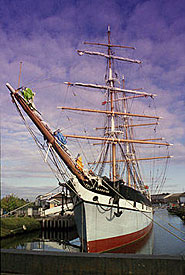
  

|
|
Polly Woodside The enchanting 1885 tall ship, the Polly Woodside, is a tangible reminder of Australia's rich maritime history and of the importance of such ships to the settlement and development. The Polly Woodside was launched in 1885 in Belfast, Ireland by Workman Clark & Co Ltd, one of the largest of the British shipbuilders, for William Woodside, a Belfast ship owner, and was named after his wife Marian's nickname, 'Polly'. Ships such as these were the lifeline for new settlers in The Colonies and critical for supplies from England and shipping and trade along the coast. From 1885 to 1904 the ship made 17 trips to all parts of the world, including South and North America, Africa and Australia, and rounded the infamous Cape Horn 16 times. In 1904 she was sold to a New Zealand firm and renamed 'Rona' and operated mainly between Australia and New Zealand. Eventually the increased competition provided by steamships meant that the ship had the mast and yards removed and was towed to Melbourne to be used as a coal lighter. In 1943 the 'Rona' was temporarily requisitioned by the Royal Australian Navy and towed to New Guinea waters for use as a refueling barge for naval ships. After the Second World War, the ship was towed back to Melbourne, and for the next 20 years was again used for supplying coal to other ships. Restoration The survival of the Polly Woodside is in part due to her having been noticed by the US sailing ship enthusiast, Kark Kortum, during a visit to Melbourne in 1946. In 1961 he aroused the interest of E Graeme Robertson, a Councillor of the National Trust with a particular interest in and great knowledge of wrought and cast iron, who was mainly responsible for saving the ship. By 1968, 'Rona' was the last square-rigged, deep water, commercial sailing ship still afloat in Australasia. In that year the then owner, Howard Smith Industries, sold it to the National Trust of Australia (Victoria) for one cent, for restoration under her original name. Extensive and meticulous research was undertaken and from 1972-78 the Polly Woodside was restored as a museum ship where visitors could discover and understand both the technical aspects of a nineteenth century sailing ship and the experience of life aboard for the crew. Much of the work of restoring the ship was done by a dedicated band of volunteers, many of whom are still involved with the continued hard work of keeping Polly 'ship shape'. For more that forty years Polly has been a much loved source of joy to the hundreds of thousands of visitors who have climbed aboard to experience life about a true 'Cape Horner'. In 2007, the ship was added to the Victorian Heritage Register and now enjoys the highest level of State heritage protection. In 2008 Polly Woodside and the Maritime Museum receibed 1 billion dollar renovation and re-opened in 2009. Some Points of Interest * The Polly Woodside is a three-masted iron barque. The hull is of riveted wrought iron * The main mast is as high as a 10 storey building * The estimated size of the sails is 1,110 sq metres (about the size of an Olympic swimming pool!) * She was noted for her beautiful lines and speed, being both fast for its size and class and capable in good conditions of travelling at up to 14 knots (26 km per hour) * In 1988 Polly was awarded the World Ship Trust Medal for supreme achievement in the preservation of Maritime Heritage, the first merchant ship in the world to be awarded this prestigious award. This is recognition of the international importance of the Polly Woodside and the quality of the restoration. She is in the company a select number of famous ships such as the 'Mary Rose' and the SS 'Great Britain'. | |
| <© Copyright Wilkins Tourist Maps Pty Ltd | |